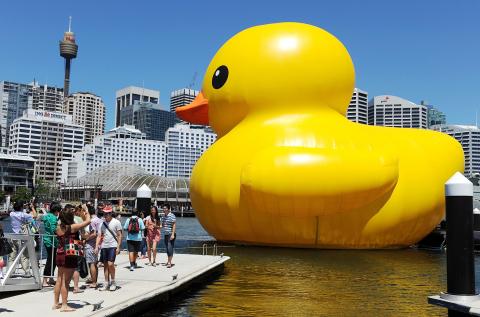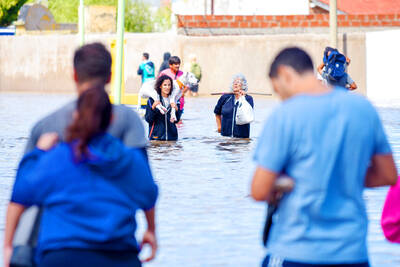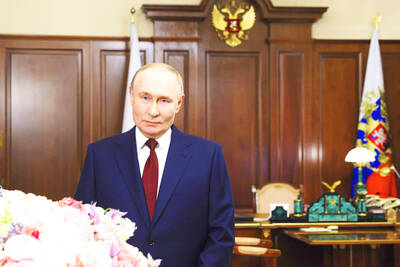A gigantic, bright yellow rubber duck floated into Sydney’s Darling Harbour yesterday as part of the Australian city’s annual arts festival, a celebration where high art meets popular entertainment.
Each January hundreds of thousands of people attend theater, music, dance, film, talks and other events for three weeks, often braving sweltering summer temperatures and thunderstorms for their dose of culture.
This year’s festival, which will present 92 events from some 750 artists from 17 countries, kicked off yesterday under bright sunshine, with thousands lining Darling Harbour for the entry of artist Florentijn Hofman’s inflatable duck.

Photo: AFP
“What makes Sydney Festival unique I think is this amazing blend of serious art and quirky and playful entertainment,” festival director Lieven Bertels told reporters. “And what better to celebrate that than with a really, lovely public art work such as the rubber duck.”
Bertels said the duck — a 15m high creation by Dutchman Hofman, models of which have appeared in other cities — appealed to the young and old, bringing back childhood memories for some.
“This is the Sydney duck and for him [Hofman] what’s important about it is that it is not just a playful thing, but also one that connects,” Bertels said.
“Because his whole theory around this, which is quite beautiful, is that all these harbors are connected to the local seas, and all these seas are part of one big ocean. So he says, well, really the whole world is one big bathtub. And what better way to celebrate summer than to have a giant bathtub party,” he added.
Many Sydney Festival events, such as the duck’s arrival, are free and family-oriented to showcase the personality of Australia’s biggest city.
This year the big attractions will be a sexy Latino circus show from Circolombia and soul singer Sharon Jones and The Dap-Kings, but the Jan. 5 to 27 festival will also present an interpretation of Handel’s opera Semele and encompass an exhibition of works by painter Francis Bacon.
Quirky events include a performance by an actor who will run a full marathon on a treadmill in front of spectators at Sydney’s Hyde Park while wearing gold sneakers and recounting an ancient Greek tale.
Sydney Festival was designed to bring life back into the city during the slow summer months.
It first took place in 1977 and has since then grown to become one of the country’s largest annual cultural celebrations.
“For me, from my European perspective, what made it really unique is this amazing way where you can combine high art and entertainment and very popular stuff all in one festival which is something you don’t often do in European arts festivals,” Belgium-born Bertels said.

ANGER: A video shared online showed residents in a neighborhood confronting the national security minister, attempting to drag her toward floodwaters Argentina’s port city of Bahia Blanca has been “destroyed” after being pummeled by a year’s worth of rain in a matter of hours, killing 13 and driving hundreds from their homes, authorities said on Saturday. Two young girls — reportedly aged four and one — were missing after possibly being swept away by floodwaters in the wake of Friday’s storm. The deluge left hospital rooms underwater, turned neighborhoods into islands and cut electricity to swaths of the city. Argentine Minister of National Security Patricia Bullrich said Bahia Blanca was “destroyed.” The death toll rose to 13 on Saturday, up from 10 on Friday, authorities

Local officials from Russia’s ruling party have caused controversy by presenting mothers of soldiers killed in Ukraine with gifts of meat grinders, an appliance widely used to describe Russia’s brutal tactics on the front line. The United Russia party in the northern Murmansk region posted photographs on social media showing officials smiling as they visited bereaved mothers with gifts of flowers and boxed meat grinders for International Women’s Day on Saturday, which is widely celebrated in Russia. The post included a message thanking the “dear moms” for their “strength of spirit and the love you put into bringing up your sons.” It

DEBT BREAK: Friedrich Merz has vowed to do ‘whatever it takes’ to free up more money for defense and infrastructure at a time of growing geopolitical uncertainty Germany’s likely next leader Friedrich Merz was set yesterday to defend his unprecedented plans to massively ramp up defense and infrastructure spending in the Bundestag as lawmakers begin debating the proposals. Merz unveiled the plans last week, vowing his center-right Christian Democratic Union (CDU)/Christian Social Union (CSU) bloc and the center-left Social Democratic Party (SPD) — in talks to form a coalition after last month’s elections — would quickly push them through before the end of the current legislature. Fraying Europe-US ties under US President Donald Trump have fueled calls for Germany, long dependent on the US security umbrella, to quickly

In front of a secluded temple in southwestern China, Duan Ruru skillfully executes a series of chops and strikes, practicing kung fu techniques she has spent a decade mastering. Chinese martial arts have long been considered a male-dominated sphere, but a cohort of Generation Z women like Duan is challenging that assumption and generating publicity for their particular school of kung fu. “Since I was little, I’ve had a love for martial arts... I thought that girls learning martial arts was super swaggy,” Duan, 23, said. The ancient Emei school where she trains in the mountains of China’s Sichuan Province